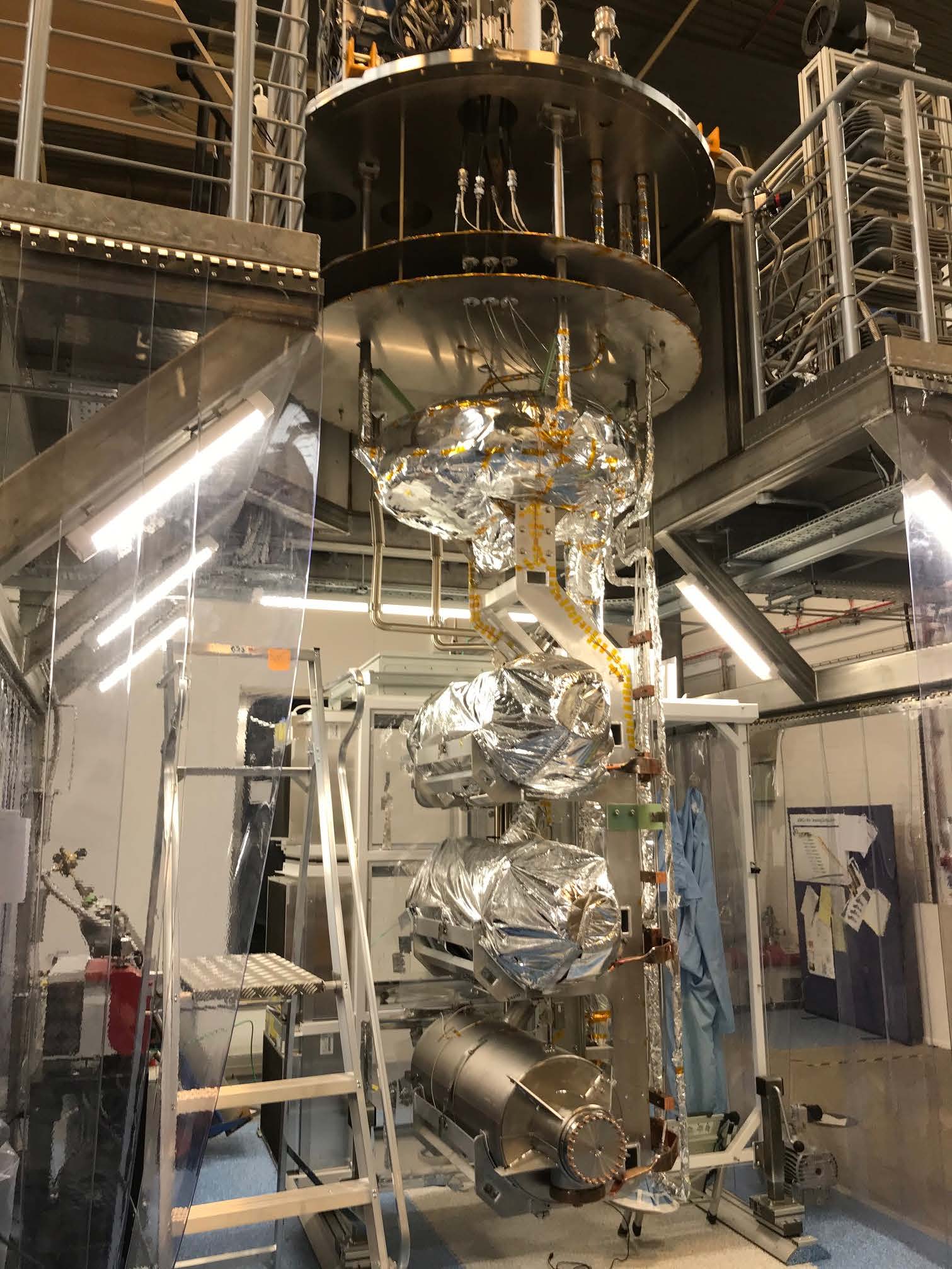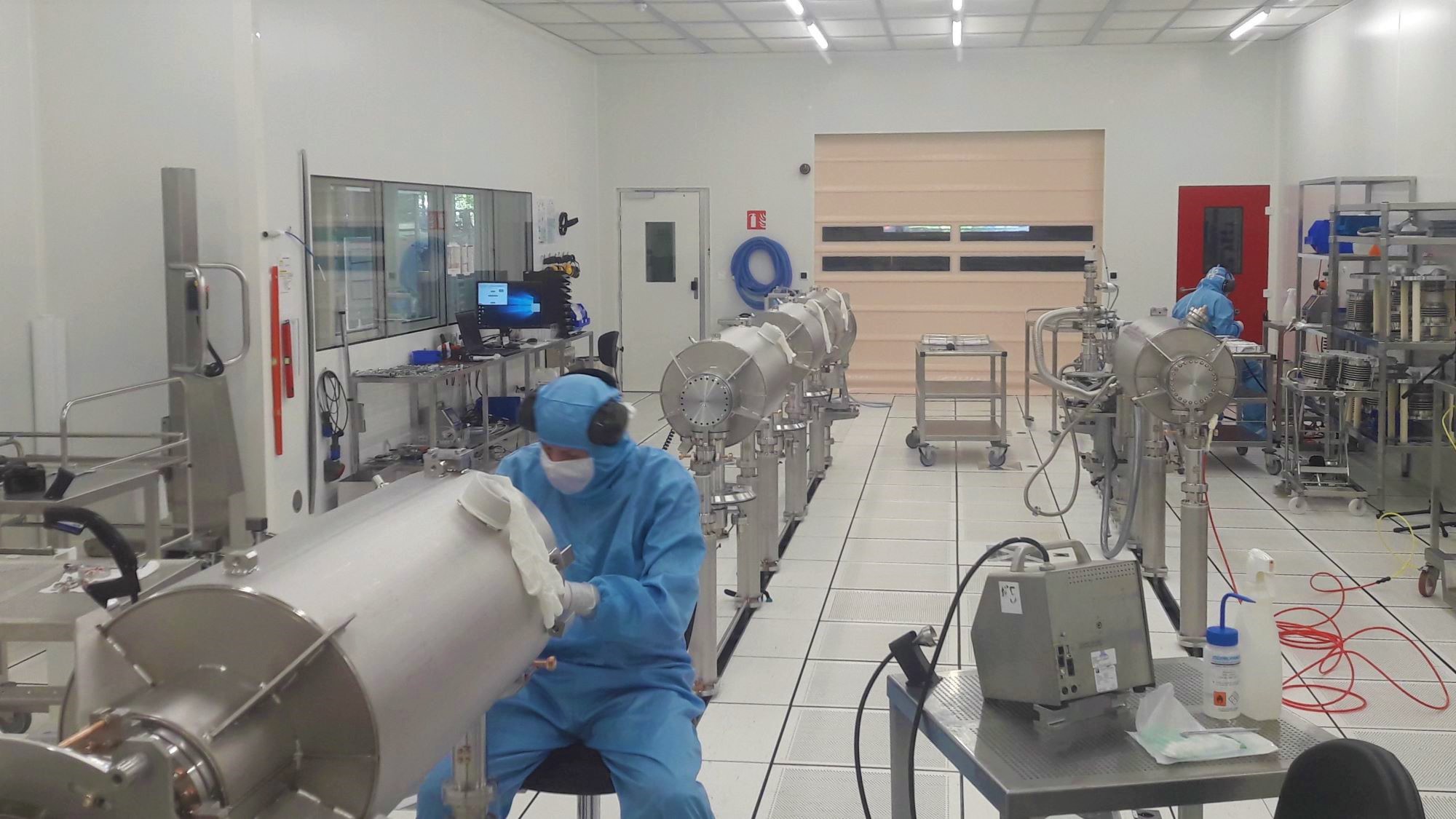Teams at Daresbury Laboratory are celebrating key milestones, with the receipt, testing, assessment and delivery of high-beta superconducting cavities destined for the European Spallation Source (ESS) in Sweden now firmly underway.
A crucial part of the ESS jigsaw
When complete, the ESS will be a powerful neutron accelerator and will in effect be a giant neutron microscope, which will have huge implications for new medicines, materials, technology and much more.
Built in Europe, the 88 high-beta superconducting cavities are a crucial part of the ESS. The high energy section of ESS will have 21 cryomodules, each containing four of these high-beta cavities. The cavities will determine how fast the protons will travel along the linear accelerator. For optimum results, the ESS team expect to accelerate the protons up to ~90% of the speed of light when it is brought in to action for its users in a few years' time. In order to achieve this, the cavities are superconducting and will also need to be in full working order and as clean as possible when they are assembled and installed. This is where the work at Daresbury Laboratory comes in.
Clean and efficient cavities
In order to validate the cavities at STFC, a purpose-built vertical test facility has been created, called SuRFLab. This includes a cryostat housed in a well which is shielded by a concrete bunker. This elaborate-sounding set up allows special cryogenic inserts which hold up to three cavities at a time, to be safely lowered inside and cooled to less than 2 Kelvin using liquid helium. Once they are cooled, a Radio Frequency (RF) amplifier is used to provide power to ensure the cavities can produce sufficiently high electric fields to accelerate the particle beam. In the final accelerator, this beam of particles will be fired into a large rotating Tungsten target to generate an intense beam of neutrons. Each cavity needs to achieve the necessary accelerating voltage using a minimal amount of RF power. If the accelerating voltage is not achieved within RF power limits, the 1.2 m long, >90 kg cavity will typically require re-cleaning and preparing in a semi-conductor class cleanroom and re-testing . Once verified, all test and verification documentation is prepared and approved by STFC and ESS. The cavity is then ready for shipping to CEA Saclay in France, an ESS partner organisation in France, for them to integrate into final-stage accelerating cryomodules.
Each round of testing takes approximately two weeks for the three cavities loaded on the cryogenic insert in the test facility, whilst another three cavities are simultaneously being prepared. A small number of cavities have also been tested at DESY in parallel, in order to mitigate schedule impacts from Covid19 and Brexit, and the STFC project team greatly thank the DESY team for their assistance. The team at Daresbury are now on track to complete the testing and assessment of all remaining high-beta cavities – out of 88 in total – by early 2023.
 CSI on stand with three jacketed cavities installed
CSI on stand with three jacketed cavities installed
To date, ten qualified cavities have been delivered for final stage assembly. Of those, four are already being assembled into the first High-Beta cryomodule at CEA Saclay, which will expect to be ready for final testing as a complete module by the end of this year.
 Cavity build at CEA (Credit: CEA Saclay)
Cavity build at CEA (Credit: CEA Saclay)
Helium efficiency as standard
Cavity testing traditionally uses large amounts of liquid helium (LHe) to fully cool the cavities to their operating temperature. LHe is a globally finite and costly resource and the innovative vertical test facility at Daresbury Laboratory has been designed to use up to 70% less LHe than traditional test facilities by using the existing cavity helium jacket as a more efficient method for cooling on the test stand. They also recycle the helium gas which is boiled-off during testing, so that it can be reused. Each of these provide significant environmental and energy savings over the life cycle of the testing to be completed.
Team work
These major milestones represent the cumulative output of many other milestones recently completed, including:
- The SuRF Lab achieving readiness for operations after completing commissioning on 30 June, and beginning the transition on 1 July toward full production test operations
- Final agreement and confirmation of the data provision and data sharing mechanisms to ESS, to provide essential manufacturing and performance data for each cavity to enable effective integration and operation of each cavity
- Receipt of a further 26 production cavities from the manufacturer Research Instruments GmbH in Germany. In all, 66 cavities, or 75% of the total required, have now been completed and delivered.
For many of the team involved at STFC, the project to provide these high-performance superconducting cavities started in 2015/16, with the design and procurement of the SuRF Lab facility systems, procurement of the specialist materials and services required to manufacture the cavities. This is therefore a monumental moment for all of those critical staff involved over the past five years.
ASTeC Project Manager, Mike Ellis, commented: "The whole team involved in this delivery should be proud of the fantastic achievement and the sheer volume of challenges and obstacles overcome on the way. These have included technical challenges of achieving world-class superconducting radio frequency performance on a production scale, new ways of working and managing data at STFC, financial challenges with a compressed cost envelope and timescales, managing interfaces with multiple external international partners and stakeholders, and more recently, serious challenges relating to customs clearances and duties which could not have been foreseen in 2016. Despite these, being able to deliver in time to maintain external partner's timescales has been a major success overall for the project, and we look forward to the challenge now of continuing to meet the required test pace and performance through to 2023!"
Mark Pendleton, SuRF Lab Operations Manager, knows only too well how much hard work has gone into getting this far: "Congratulations to all technical teams involved for the design, installation and commissioning of the new SuRF Lab facility, housing a bespoke vertical test stand and cleanroom suites.
"This is the result of hard work and commitment from the team members over a number of years, and finally completing all preparations and commissioning throughout the pandemic. The team managed to overcome huge challenges and develop new ways of working to ensure that the facility was available on- time for the testing and reprocessing of high-beta cavities. Another key milestone to acknowledge was achieving the goal of testing three high-beta cavities in two weeks on the very first test run."
 SuRF Lab Team October 2021
SuRF Lab Team October 2021
This now marks the start of another important stage in the project, where the testing, assessment and delivery of cavities will need to operate with a 'steady-state' drumbeat to ensure timely and regular availability to meet the necessary build and assembly schedule at our fellow ESS SRF collaborator, CEA Saclay.
Peter McIntosh, the STFC Project Sponsor, said: "It's fantastic to see how the incredible work of the DL team is having such a significant impact in enabling the earlier start of high-beta cryomodule assembly at CEA in France and ensuring the ESS project itself can achieve its ultimate energy expectations."
